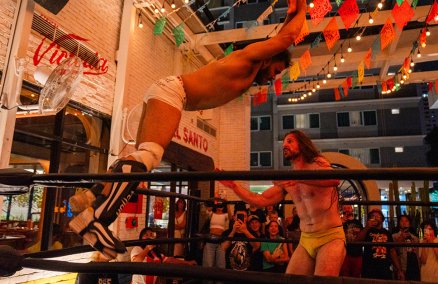How did the Molam Bus project start?
It originated from Khon Kaen University, where they were preparing to build a molam museum. But the project was eventually terminated when the government didn’t stump up the funding it promised. The university had previously awarded us [Jim Thompson Foundation] for our work preserving traditional Isaan houses at our Jim Thompson Farm, so we asked them to give us this project. We ran a molam competition among students, which we transformed into a molam exhibition, “Khaen Long Khanong Lam” (Joyful Khaen, Joyful Dance), at Jim Thompson House in Bangkok three years ago. Then we decided to transform it into a traveling bus.
Where did you get the bus?
It’s actually an old bus we’ve been using since the ‘70s to transport our employees in Nakhon Ratchasima. We worked with Jiro Endo, a Japanese designer, and the molam bus exhibition was originally shown at Jim Thompson Farm. We decided to bring it to Wonderfuit to showcase live molam music. We see it as a mobile museum. It wasn’t easy to drive here, though, as the bus is so old. It took us one night to drive from Korat to Chonburi.
What’s been the feedback so far?
It’s been really varied. The people at Wonderfruit had a lot of fun with it. Some climbed on top of it and struck yoga poses. The people at the farm were more subdued, but also really interacted with the exhibition. It’s separated into three phases that chart the history and subsequent commercialization of the music. Some of the Wonderfruit audience love molam just as much as they enjoy Western dance music—some even plan to book the bands for their wedding!
How many bands have joined you?
So far, we’ve worked with four bands, led by Sombat Simla, aka the “God of Khaen.” We want to bring in more famous molam bands but, you know, they are really, really busy. Some tour around playing more than 200 shows in 365 days! There’s no way anyone can say molam is dead.
Why do you think Isaan culture is so enduring?
We’re so interested in Isaan culture, especially molam, because we see it as this great undead culture. Molam music has such a universal appeal that easily transcends borders. This may be due to the nature of the Isaan people themselves, many of whom need to travel long distances to earn a living. This gives them a wider perception of the world, which impacts their own culture. Culture is in constant flux; when you try to freeze traditions so that nothing changes, that’s when a culture dies. Unlike, say, Thai court traditions, Isaan culture is all about everyday life. It can never die. I really appreciate what DJ Maft Sai is doing by taking molam to global audiences, too.
What’s next for the Molam Bus?
We plan to take it on the road, but we don’t have anywhere specific yet. We’re concerned about driving it too far, as it’s really, really old.















